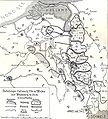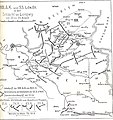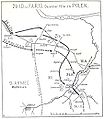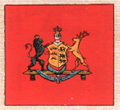Infantry Regiment "Kaiser Friedrich, King of Prussia" (7th Württembergisches) No. 125
|
Royal Württemberg Infantry Regiment "Kaiser Friedrich, King of Prussia" (7th Württemberg) No. 125 |
|
|---|---|
| active | 1809 to 1919 |
| Country |
|
| Armed forces | Württemberg Army |
| Branch of service | infantry |
| Type | Infantry regiment |
| structure | See outline |
| Insinuation | XIII. (Royal Württemberg) Army Corps |
| Location | See garrisons |
| march | Presentation march: “March of King Friedrich Wilhelm III.” ( AM I, 2) ; Parade march: "March from Petersburg" (AM II, 120) |
| management | |
| Commanders | See list of commanders |
The Infantry Regiment "Emperor Frederick, King of Prussia" (7 Württembergisches) no. 125 was from 1809 to 1919 an infantry joined the Württemberg army .
history
Surname
In August 1809 from the Depot - companies of the against Austria fighting infantry regiments, the infantry regiment "of Scharffenstein" with two battalions positioned and renamed on 27 May 1811 Infantry Regiment 8th . After the campaign against Prussia in 1813, the 7th Infantry Regiment that had been destroyed there was no longer reorganized; instead, the regiment received this number in November and became Infantry Regiment No. 7 . At the same time it gave up the 1st Battalion and was replenished with the remnants of the returned regiments. During the military reform in 1817, the regiment kept its name.
After the military convention with the North German Confederation of 21./25. On November 2, 1870, like all Wuerttemberg troops, it was given the appropriate addition 7th Württemberg Infantry Regiment to distinguish it from troops from other German states . On December 18, 1871, all Württemberg regiments received additional numbers. These corresponded to the consecutive numbering of all regiments of the German Armed Forces, regardless of their affiliation to one of the contingents, the regiment was given the number 125: 7th Württemberg Infantry Regiment No. 125 . On March 20, 1888, the regiment was given its final name Infantry Regiment "Kaiser Friedrich, King of Prussia" (7th Württembergisches) No. 125 .
On April 30, 1919, the regiment was disbanded.
The tradition took over in the Reichswehr by decree of the Chief of the Army Command General of the Infantry Hans von Seeckt from August 24th 1921 the 3rd and 4th Companies of the 13th (Württemberg) Infantry Regiment .
Garrisons
- 1809 Ludwigsburg
- 1811 Ravensburg
- 1812 Mergentheim , then Ulm
- 1813 Ludwigsburg
- 1814 Neustadt
- 1815 Ulm
- 1833 Stuttgart
- 1837 Ludwigsburg
- 1849 Ulm
- 1866 Stuttgart
- 1875 Fusilier Battalion Tübingen
- 1884 Fusilier Battalion, Ulm
- 1897 whole regiment in Stuttgart
Participation in skirmishes and combat operations
- 1813 on the side of the coalition against France in the Württemberg corps "Walsleben". Strength 30 officers and 1,200 men. Used by Kehl , losses unknown.
- 1814 in the war against France with the main army (Württemberg corps in IV. Corps). The regiment took part in the battles at Épinal , Chaumont , Brienne , Sens , Montereau and Paris . Losses not known.
- 1815 against France in the 4th Army " von Schwarzenberg ".
- In 1847/49 the regiment was used to suppress unrest in the course of the Baden Revolution in Württemberg and Baden.
- In the German War in 1866 , the regiment was part of the Württemberg Division (1st Brigade) in the VIII Federal Army Corps and fought at Tauberbischofsheim with a strength of around 30 officers and 1,400 men . Losses not known.
- 1870/71 against France . The regiment moved out with a total strength of 2,110 men and fought at Wörth , Villiers, Champigny and before Paris . Losses: 4 officers, 21 non-commissioned officers and 202 men killed, 14 officers and 327 non-commissioned officers and men wounded, 1 non-commissioned officer and 28 men died.
- In 1900 an unknown number of soldiers from the regiment took part in the second international expeditionary force in China. A non-commissioned officer was wounded.
- 1904/06 soldiers of the regiment also took part in the fight against the Herero . Losses: 2 deceased.
- During the First World War , the regiment fought on different fronts.
- The XIII. (Royal Wuerttemberg) Army Corps initially fought in the Argonne . From December 1, 1914, the 26th Division (1st Royal Württemberg) and the Grand Ducal Hessian (25th) Division (with subordinate Württemberg Field Artillery Regiment No. 132) formed the XIII. Corps with the 9th Army ( Mackensen ), in Poland and advanced to the Bzura near Kozlow .
- In March 1915 the XIII. Army Corps of the 12th Army subordinated to Gallwitz and relocated north to Przasnysz . From July to August she was involved in the breakthrough over the Narew and reached the Nyemen . In September the division was detached from the eastern front and moved by rail to the area west of Belgrade . On November 1, she was the XXII. Reserve Corps ( Falkenhayn ), 3rd Austrian-Hungarian. Army ( Köveß ), subordinated and advanced to Kraljevo by mid-November . In December the XIII. Army Corps with the 26th Infantry Division and the Field Artillery Regiment No. 13 relocated to the western front in the area west of Ypres .
- In 1916 the regiment was used as part of the division in the Battle of the Somme .
- In 1917 the division was used in the Battle of Arras and in the Second Battle of Flanders . From September 12th she was moved from Zabern to the Klagenfurt area, where she arrived on October 7th, with the 200th Jäger Division in the General Command z. b. V. 51 and equipped and trained for fighting in the mountains. From October 24th, the division took part in the fighting in Veneto ( Twelfth Isonzo Battle and First Piave Battle ) and reached the Piave , where it remained until December 6th. The regiment captured around 12,000 men and captured u. a. 44 artillery pieces, 400 machine guns, 100 trucks and 527 other vehicles as well as 800 horses. The division was then moved to the Molsheim area for training behind the front and came to Valenciennes in March 1918 .
- During the German spring offensive in 1918 , the division advanced to Beaumont in Operation Michael and was then used at Reims . In the fighting against retreat, she went back to the Antwerp-Maas position , from where, after the Armistice of Compiègne , she marched back on foot via Prüm , Linz on the Rhine and Ferndorf to the Marburg area . From there the regiment reached its peace garrison in Württemberg.
- The total losses were 3,949 dead and 9,017 wounded.
Battle of Longwy 1914
assignment
The regiment had the order to lead the infantry fire fight. In peacetime, the soldiers were trained to use appropriate weapons and as patient carriers.
organization
Association membership
Until 1816 there were no major associations in Württemberg during peace . Such were only put together for individual campaigns.
With the fundamental reorganization in 1817, the Württemberg army was divided into large units for the first time in peacetime. Together with the 8th Infantry Regiment, the regiment formed the 4th Brigade in the 2nd Division . In July 1849 a reorganization of the Württemberg army was ordered again. The infantry was grouped into just one division (without a number).
From 1871 to 1914 the regiment belonged to the 51st Infantry Brigade (1st Royal Württembergische) in Ulm , 26th Division (1st Royal Württembergische), XIII. (Royal Württemberg Army Corps, 5th Army.
In the First World War, the peace structure initially remained. From March 1917 the 26th Division (like all German divisions) was independent, but remained with the new XIII. General Command.
structure
Until 1871 the regiment consisted of two battalions .
On November 15, 1874, the third ( Fusilier ) battalion was added, formed from the 12th Company Infantry Regiment "Kaiser Wilhelm, King of Prussia" (2nd Württemberg) No. 120 , 10th Company Infantry Regiment "Alt-Württemberg "(3rd Württembergisches) No. 121 , 11th Company Grenadier Regiment" König Karl "(5th Württembergisches) No. 123 and a company from the 51st Infantry Brigade (1st Royal Württembergische).
On October 2, 1893, the IV. Battalion was set up as a (half) battalion. It was on October 1, 1913 for the establishment of the III. Battalion of the 10th Württemberg Infantry Regiment No. 180 surrendered.
Levies
- At the end of 1813 the 1st Battalion to reorganize Infantry Regiment No. 4
- 1859 NCOs and men for the formation of the 1st and 2nd Jäger Battalions
- 1865 46 NCOs and men for the formation of the 3rd Jäger Battalion
- November 1, 1872 the 7th company for the formation of the III. Battalion Infantry Regiment "Alt-Württemberg" (3rd Württembergisches) No. 121
- November 1, 1873 the 2nd company for the formation of the III. Battalion Fusilier Regiment "Emperor Franz Josef of Austria, King of Hungary" (4th Württembergisches) No. 122
- October 1, 1913 the 7th company for the formation of the III. Battalion 9th Württemberg Infantry Regiment No. 127
All of these taxes were re-established from the regiment.
- On April 1, 1897, the 4th (half) battalion was transferred to the 10th Württemberg Infantry Regiment No. 180 .
Commanders
| No. | Rank | Surname | Beginning of the appointment |
|---|---|---|---|
| 1. | Colonel | Wilhelm von Pöllnitz | July 24, 1809 |
| 2. | Colonel | Peter von Biberstein | February 29, 1812 to February 2, 1813 |
| 3. | Colonel | Rudolf von Bünau | February 3 to 12, 1813 |
| 4th | Colonel | Christian von Kellenbach | February 13 to October 24, 1813 |
| Leader of the regiment | major | Wilhelm Karl Friedrich von Nettelhorst | February 26 to May 28, 1814 |
| 5. | Colonel | Fidel from King | December 31, 1819 to May 17, 1821 |
| 6th | Colonel | Friederich von Hohorst | May 18, 1821 |
| 7th | Colonel | Karl von Seybothen | April 15, 1825 |
| 8th. | Colonel | Friedrich von Sattler | June 10, 1833 |
| 9. | Colonel | Friedrich of Württemberg | October 28, 1833 to September 25, 1834 |
| 10. | Colonel | Friedrich von Sattler | September 26, 1834 to November 1, 1840 |
| 11. | Colonel | Friedrich Arand von Ackerfeld | November 9, 1840 to March 17, 1844 |
| 12. | Colonel | Christoph Friederich von Rampacher | March 25 to November 6, 1844 |
| 13. | Colonel | Adam von Lenz | November 17, 1844 |
| 14th | Colonel | Albrecht von Baldinger | January 11, 1850 to September 13, 1857 |
| 15th | Lieutenant Colonel / Colonel | Joseph von Zischwitz | September 21, 1857 to June 14, 1862 |
| 16. | Colonel | Albert von Hügel | June 23, 1862 |
| 17th | Colonel | Hermann von Rampacher | September 20, 1869 to October 2, 1871 |
| 18th | Colonel | Lothar von Egloffstein | November 27, 1871 to February 6, 1876 |
| 19th | Lieutenant Colonel / Colonel | Wilhelm von Woelckern | March 4, 1876 to August 3, 1883 |
| 20th | Lieutenant Colonel / Colonel | Heinrich von Reibel | October 13, 1883 to November 4, 1886 |
| 21st | Colonel | Theodor von Sprösser | November 8, 1886 |
| 22nd | Prussia. Colonel | Friedrich von Gersdorff | June 25, 1889 to March 24, 1890 |
| 23. | Colonel | Theodor von Bullinger | March 25, 1890 to January 8, 1892 |
| 24. | Lieutenant Colonel / Colonel | Anton von Rummel | January 15 to November 10, 1892 |
| 25th | Colonel | by Camerer | September 7, 1892 |
| 26th | Colonel | Adolf von Fetter | May 14, 1894 |
| 27. | Colonel | Karl von Muff | July 20, 1897 to June 3, 1899 |
| 28. | Colonel | Hermann von Monsterberg | June 4, 1899 to February 6, 1903 |
| 29 | Colonel | Franz von Soden | February 25, 1903 |
| 30th | Colonel | Wilhelm Freiherr von Brand | May 21, 1906 |
| 31. | Lieutenant Colonel / Colonel | Julius von Ferling | January 27, 1909 |
| 32. | Colonel | Alfred von Roschmann | January 1911 |
| 33. | Colonel | Christoph von Ebbinghaus | November 20, 1913 |
| 34. | Colonel | Adolf von Martin (fallen) | October 1, 1914 |
| 35. | Colonel | Christoph von Ebbinghaus | December 16, 1914 |
| 36. | Colonel | Reinhold Stühmke | October 27, 1915 |
| 37. | Lieutenant colonel | Hugo Flaischlen | June 14, 1918 |
| Leader of the regiment | Major Kurt von Lupine ( Gren. Regt 123 ) Major Emil von Schnizer Major Theodor Freiherr von Schellerer ( Ul. Regt. 20 ) Major von Sprösser |
temporarily 1914–1918 |
Heads of regiments
Regimental owner:
- 1809: Lieutenant General Georg Friedrich Scharffenstein
- 1811: vacant
- June 10, 1814: Lieutenant General Christian Johann von Koch
- 1815: vacant
- March 20, 1888: Emperor Friedrich
Armament and equipment
Main armament
In 1822 10 men per company were appointed riflemen who received rifles with sights. They were also specially trained in all branches of service and in the skirmish service and formed the reservoir for the emergence of the NCOs.
Rifles with percussion locks were introduced in 1831, the Minié rifle in 1851 , the Mauser M71 rifle from 1871 and the Karabiner 98 from 1898 . At the beginning of the First World War each infantry regiment had 6 heavy machine guns , at the end of 1917 36 heavy and 72 light machine guns .
uniform
- 1813 Blue Colett with a yellow collar, blue borders with two rows of white buttons, yellow Polish lapels and yellow piping , white trousers, black shoes and gaiters . Caterpillar helmet with red and yellow plume.
- 1817: Service coat in the months of November to April a royal blue kutka (up to an inch above the kneecap), in the months of May to October a royal blue Spenzer (up to the hips), without buttons, with a closed blue collar, yellow Polish lapels and a royal blue cloth belt . White, yellow-lined cloth epaulettes with company number. Black collar. Royal blue, half-width trousers (white trousers and gaiters in summer). Black shako made of felt with leather cover and black and red cockade. Black waist shoes (from 1820 short black gaiters and shoes). Light gray coat. The leather gear (worn under the epaulettes) was white, the cartridge black.
- 1821: Royal blue Colett with two rows of silver buttons (with regimental number) on the front, red closed collar and blue Polish lapels with red piping. Blue pants with red piping.
- 1845: Shako made of sheep's wool felt with a cover of blue cloth with a white upper edge, from 1846 with a royal blue bush.
- 1849: Single-breasted blue tunic with white buttons and red collar. Armpit flaps with regimental number.
- 1864: Dark blue, red lined skirt with two rows of buttons, four buttons on the back, sleeves with red piping, shoulder flaps with shoulder bulges and blue regimental number. Dark gray pants. Dark blue hats with red piping. The epaulettes are omitted, as badges of rank stars on the collar as in Austria.
- 1871: Prussian helmet ( spiked hood ) with Württemberg coat of arms and the motto "Fearless and trew"
- 1874: Uniform according to Prussian standards, but still double-breasted tunic until 1892.
- 1888: "FR" with crown on the armpit flaps.
- 1897: German and Württemberg cockades on the helmet
banner
When it was deployed, the regiment received two flags. The cloth was square in blue and white with gold fringes on all sides. On one side was the golden crowned signature "FR", on the other side the crowned Württemberg coat of arms with coat of arms . On July 7, 1814, it received two more flags made of dark blue silk with yellow fringes (approx. 125 cm × 125 cm), on the front the monogram "FR" with a royal crown, on the back the small royal coat of arms. As with all regiments, on October 4, 1818, the flags were replaced by standards, which were replaced by new flags by the Supreme Order of September 3, 1851. Each battalion received a flag made of burgundy-red cloth with light green fringes on all sides. In the middle of one side was the gold and yellow crowned name “W”, the other side the Württemberg coat of arms held by a yellow deer and a black lion, the inscription “Feartlos und trew” on a blue foreign exchange ribbon and the white cross of the Order of Military Merit .
The Fusilier Battalion received its flag on December 2, 1874. It was like the flags from 1851, but without a fringe and with the crowned signature "K". It was replaced by the same one in 1909, but with the crowned signature "W".
The 4th Battalion received its flag on December 3, 1894. They corresponded to those of the regiment from 1851, but without a fringe and with the crowned signature "W". It stayed with the regiment when the battalion was handed over and was carried as a second flag by the 1st battalion.
Others
- The 1st Company won the King's Prize in 1896, 1897 and 1898, the 8th Company in 1906 and the 9th Company in 1902.
- The Siebener Memorial in Stuttgart, erected in 1927, commemorates the fallen of the regiment.
Persons in the regiment
- December 2, 1893 General of the Infantry von Woelckeren
- September 7, 1909 Captain Eitel Friedrich of Prussia
References
swell
- Main State Archive Stuttgart : Holdings M 96.
Web links
literature
- Schnürrer: History of the 7th Württemberg Infantry Regiment No. 125 Stuttgart 1875.
- Marx: History of the Infantry Regiment Kaiser Friedrich, King of Prussia (7th Württ.) No. 125.Berlin 1895.
- Hermann Niethammer: The officer corps of the infantry regiment Kaiser Friedrich, King of Prussia (7th Württ.) No. 125 1809/1909. Stuttgart 1909.
- Niethammer: Festschrift for the centenary of the infantry regiment Kaiser Friedrich, King of Prussia (7th Württemberg) No. 125. Stuttgart 1909.
- Reinhold Stühmke: The infantry regiment "Kaiser Friedrich, King of Prussia" (7th Württ.) No. 125 in the World War 1914-1918 . Belser, Stuttgart 1923. (Volume 31 from the series The Württemberg Regiments in World War I )
- Otto von Moser : The Württemberg people in the world war. Publishing bookstore Chr.Belser AG, Stuttgart 1927.
- Günther Voigt: Germany's armies until 1918. Volume 4, Biblio Verlag, Osnabrück 1982, ISBN 3-7648-1285-0 .
- Leo Ignaz von Stadlinger: History of the Württemberg war system. K. Hofdruckerei zu Guttenberg, Stuttgart 1856.
- Hans-Joachim Harder: Military history handbook Baden-Württemberg . Edited by the Military History Research Office . Kohlhammer , Stuttgart 1987, ISBN 3-17-009856-X .
- Uniform regulations for the Royal Wuerttemberg Military. Royal Court and Chancellery Printing House Gebrüder Mäntler, Stuttgart 1818.
Remarks
- ^ Regiment "Kronprinz", Regiment "von Neubronn", Regiment "von Franquemont"
- ^ By a cabinet order of May 27, 1811 (Württ. Government Gazette 1811 Nro. 25, June 1st, p. 265.) the naming of the regiments in Württemberg was changed; instead of the name of the regiment owner, a continuous numbering was used.
-
↑ Exact strength:
30 officers (34 officer horses), 12 ensigns, 1,914 NCOs and musketeers, 72 infantry
3 doctors
1 regimental quartermaster
46 wagon horses for 12 wagons - ↑ In March 1917 the general commands of the army corps were converted into so-called group commands. These troops were no longer permanently subordinate to them, but were assigned to them alternately at times by the Supreme Army Command .
























